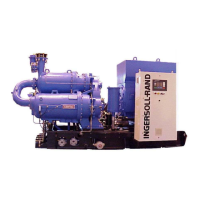
Do you have a question about the Ingersoll-Rand centac C950 and is the answer not in the manual?
| Model | C950 |
|---|---|
| Type | Centrifugal |
| Cooling Method | Water-cooled |
| Maximum Pressure | 125 psi |
| Motor Power | 950 hp (708 kW) |
| Lubrication System | Forced Feed |
Details confidential and trade secret information ownership and usage restrictions.
States manual is provided "as is" without implied warranties.
Discusses safety precautions for operating and maintaining centrifugal air compressors.
Emphasizes the importance of a robust safety program for industrial hazards.
Explains the use of WARNING, CAUTION, and NOTE for safety and operation emphasis.
Defines WARNING, CAUTION, and NOTE used for emphasis in the manual.
Details on inspecting the compressor upon arrival and documenting receipt of items.
Guidance on using experienced riggers and appropriate equipment for safe lifting.
Instructions for storing the compressor, including duration and environmental considerations.
Emphasizes proper installation for machinery reliability, cost savings, and references for details.
Discusses optimal compressor location for accessibility, maintenance, and installation space.
Considerations for indoor vs. outdoor installations, including protective measures and climate.
Guidelines for proper ventilation to avoid dust, corrosive vapors, and manage heat.
Advice on minimizing noise impact by treating reflective surfaces and avoiding certain room types.
Requirements for a stable foundation, noting static loads and the recommendation for concrete pads or steel structures.
Procedures for leveling the compressor unit using wedges or shims and machinist/transit levels.
Method for permanent installation, ensuring a uniform bearing surface with grout.
Importance of clean inlet air, filter requirements, maintenance, and piping design considerations.
Recommendations for installing spool pieces for easier maintenance access to inlet piping.
Specifies minimum requirements for high-efficiency inlet air filters and recommendations for adverse conditions.
Guidelines for mounting remote inlet air filters, including location and access requirements.
Details on supporting bypass piping to minimize flange loading and using silencers for noise reduction.
Lists conditions requiring expansion joints, such as hot air discharge and steam turbine drivers.
Guidelines for discharge piping, including spool pieces, block valves, and safety relief valves.
Strategies for parallel operation with other compressor types to manage pulsations and system integration.
Explains the function of receivers in managing air demand, efficiency, and pulsation isolation.
Details on control air quality, material, routing, and condensate management.
Specifies requirements for instrument air quality, filtering, and connection to the control panel.
Sizing, pressure, and installation of cooling water lines, including throttle and gate valves.
Detailed water quality parameters including hardness, pH, suspended solids, and Langelier index.
Function of vents to ensure coolers are full of water and proper connection for drainage.
Procedures for draining condensate from traps to prevent carryover and ensure proper operation.
Lists the electrical connections required, referencing arrangement and schematic drawings.
Specifies the voltage for control circuitry and requirements for a control transformer if needed.
Describes the two interface points required for remote starters, including feedback and on/off circuits.
Guidance on connecting three-phase power from the starter to the main motor, including checks before energizing.
Information on sizing and operation of the heater contactor for the oil reservoir heater.
Guidance on sizing and operation of the starter for the prelube pump driver.
Describes the function of the current transformer for signal provision to control panel devices.
How to connect optional switches supplied by Ingersoll-Rand to the control panel.
Importance of cleanliness and factory testing of the lubrication system, including wire seals.
Step-by-step instructions for flushing the lubrication system with oil before operation.
Specifies synthetic lubricant requirements and recommends Ingersoll-Rand's Techtrol Gold III.
Lists detailed physical and chemical requirements for lubricants based on ASTM test methods.
Provides sump and total oil system capacities for standard Centac models.
Details design pressure for lube oil cooler and micron rating for lube oil filter.
Specifies minimum oil temperatures for starting and operating bearing inlet.
Comprehensive checklist for inspecting corrosion, cleanliness, and specific piping details before initial start-up.